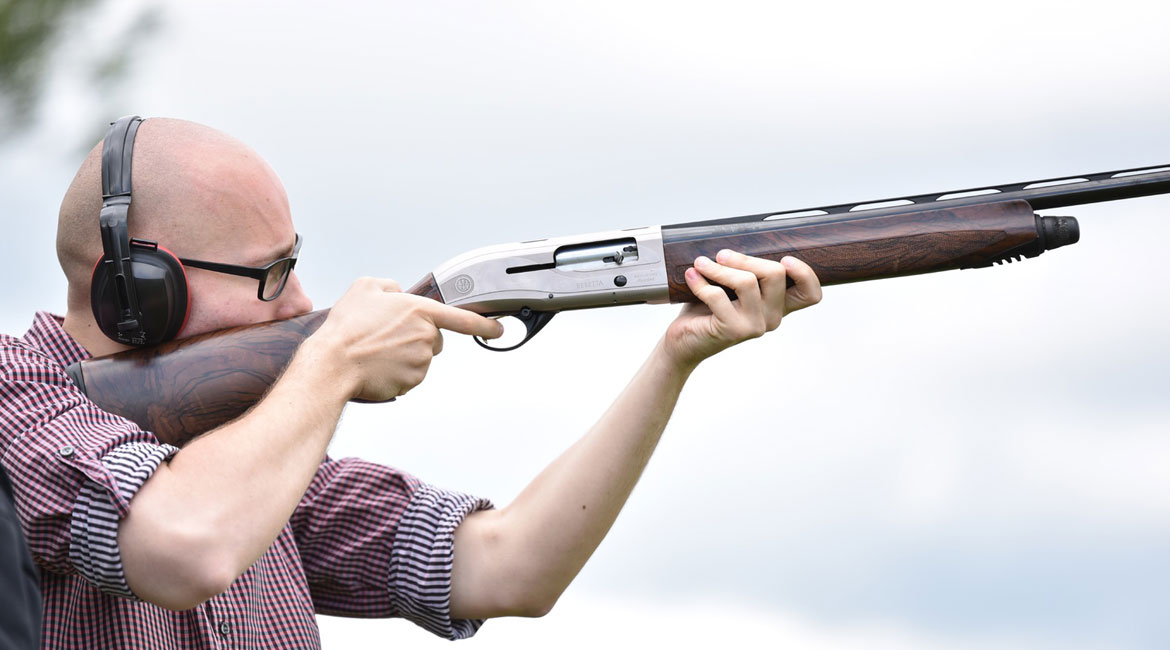Trap Shooting
Trap shooting is a specific form of clay target shooting. Trap shooting is a game of movement, action, and split-second timing. It requires the accuracy and skill to repeatedly aim, fire, and break the 4 1/4 inch disc which is hurled through the air at a speed of 42 mph, simulating the flight path of a bird fleeing a hunter.
Trap shooting’s continual growth and expanding popularity are due to the fact that people of all ages, incomes, and abilities can compete. Nine-year-old boys shoot alongside 90-year-old men. Many 70-year-olds’ have been in the sport for 55 years and some began just two years ago. Trapshooting’s participants include millionaires and hourly wage earners, inventors, and businessmen, former sports figures in other fields, professional men, farmers, truck drivers, musicians, actors, students, and housewives.
The shooter is required to shoot at a target after he calls “pull”. It does not matter in scoring if the shooter hits only a small piece of the target or whether he shatters the target. The target is considered a “dead” or “lost” bird. If the target is hit it is “dead”. If it is missed it is “lost”.
Singles is considered to be the easiest of the three disciplines. In singles, the shooter stands 16 yards away from the center of the “trap house” and shoots at random targets that fly at various angles in front of him/her. Shooters are grouped into squads, usually made up of up to five people. There are five positions that each shooter shoots from, shooting five shots at each, for a total of twenty-five shots or one round. This gives participants a different view of the target flying through the air. Each position is a constant 16 yards from the trap house, each one is spaced three feet apart forming a small arc.
Handicap is considered the most prestigious event in trap shooting. As in other sports, handicapping strives to make the competition equal. This is accomplished by having the more skilled competitors stand further away from the trap house. Based on a shooter’s past performances, a shooter is assigned a handicap distance that he/she must shoot. A competitor with a high handicap will shoot no closer than the 18-yard line, while the most skilled shooter is placed at the 27-yard line.
SKEET SHOOTING
Today’s skeet field has eight shooting stations and two trap houses. Seven of the stations are arranged in a half-moon between the two trap houses, and one station is directly between them. On the left side of the field is the high house throwing targets from a trap 10 feet above the ground. These targets rise to a height of 15 feet at the center of the field. On the right, you probably guessed it, the low house. Targets leave the low house just 3-1/2 feet from the ground and rise to the same height of 15 feet at the center of the field.
The shooting sequence is as follows:
- Stations 1 and 2: High house single; Low house single; High house/Low house pair
- Stations 3, 4, and 5: High house single; Low house single
- Stations 6 and 7: High house single; Low house single; Low house/High house pair
- Station 8: High house single; Low house single
A round of skeet consists of 25 targets, with 17 shots as singles and 8 as doubles or pairs. Doubles or pairs are two targets thrown simultaneously. Skeet is shot in squads of up to five shooters. They move from station to station around the half-moon, ending up in the center, at the end of the round.
During a round, skeet allows for an option. This occurs at the first miss and the target can be repeated. If no targets are missed during the round, the last or 25th target is shot at the last station, low house 8.
Any gauge shotgun, 12 gauge maximum, may be used, of any type, as long as it can fire at least two shots. The preferred shot size is #9, but nothing larger than 7-1/2, 1 1/8 oz should ever be used. Since strength is not a factor, women are able to compete equally with men. Left-handed shooters do just as well as right.
FIVE-STAND SHOOTING
Five-Stand is best described as putting trap, skeet, and sporting clays in a blender and Five Stand is what pours out. There is a line of five “stands” for shooters and a number of launchers arranged in front of the shooters, to their sides, and even behind them. Shooters are presented with five targets at each shooting stand, 25 targets in all. The first target at each stand is a single. Targets two and three are thrown as a designated report pair or after the shooter fires at the initial target, the second target is thrown. Targets four and five are a true double or pair, two targets are thrown simultaneously. For those who have shot skeet, this would be similar to skeet stations 1, 2, 6, and 7. This is repeated at each stand or station.
Five Stand can be more exciting than trap and throws a wider variety of patterns than skeet. The game offers several different skill levels and utilizes six or eight automatic traps to simulate game birds. For hunters, it’s a great game, giving you the chance to work on shots simulating everything from fleeing rabbits and flushing quail to ducks dropping into a set of decoys.
Match Safety Rules:
- No guns shall be loaded until the shooter is at the shooting station. “Loading” is putting any part of a loaded shell in any part of the gun.
- The gun shall be unloaded before leaving the station or changing stations.
- When not on station, carry your gun with the breech open. Pumps and automatics will have their bolt open. Fixed breech guns will be broken open.
- Store all guns in racks or in your vehicle.
- ONLY active shooters, designated pullers, shooting instructors, and referees are allowed “on the field”.
- Be alert for range personnel entering or leaving the trap houses.
- Shooters will pick up their hulls after all members of the squad have finished shooting!
- Rules of the shooting sports for the trap, establish a MAXIMUM SHOT SIZE of 1-1/8 oz., #7 ½ shot. No shotgun slugs, buckshot, or shot larger than #7 ½, or any handgun or rifle shooting on the shotgun ranges.
- The trap house is NOT A TARGET or target stand!
- Do not drive on the trap range including gravel surfaces.
Match Equipment:
- Shotgun with at least 25 Bird shotshells.
- Personal Protection Equipment; Eye and Hearing protection
Match Dates:
- For Trap, it is every Saturday morning and Every Tuesday night of every month.
- Skeet will be every 2nd and last Saturday of the month-same hours as Trap.
- 5 Stand is the third Saturday of the month-same hours as Trap.
Match Location:
Boulder Rifle and Pistol Club Shotgun Range
Match Times:
- 8:00 A.M. to 12 P.M. Every Saturday
- 7:00 P.M. to 9:00 P.M. Every Tuesday
Match Fees:
All fees are collected at the match event.
Associated Trap Organizations:
Amateur Trapshooting Association (ATA)
Nevada State Trap Shooting Association
Pacific International Trapshooting Association (PITA)
More Information:
Contact the Trap Lead: [email protected]

